PhD: listening with residents to urban seaside gentrification 2018-2022
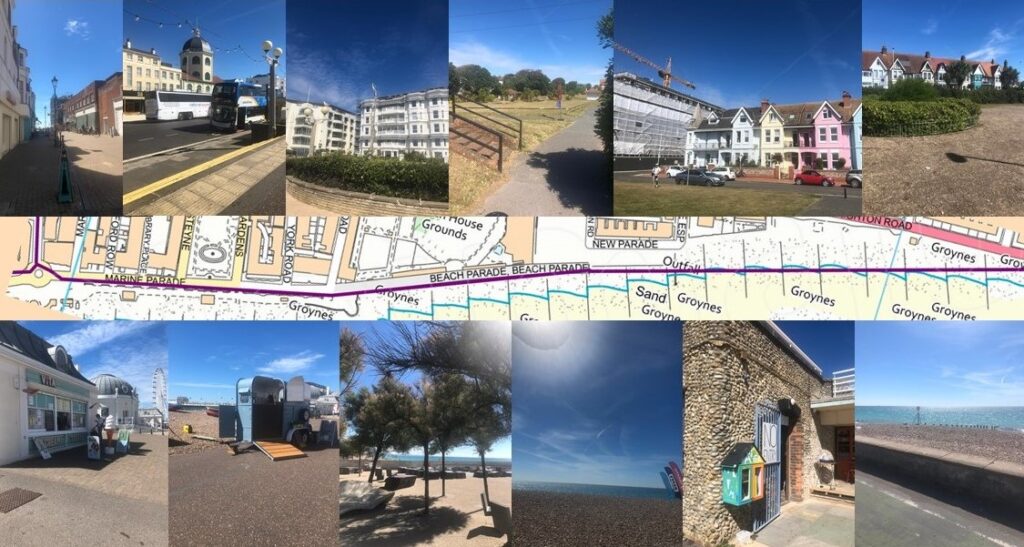
What can listening with residents on the UK south coast tell us about urban seaside gentrification and displacement injustices?
This doctoral project developed the participatory listening research approach to investigate residential experiences of gentrification at the under-researched English urban seaside, focusing on 3 Sussex neighbourhoods in Brighton, Worthing & St Leonards-on-Sea. One resident aptly defined gentrification as “the poshing up of a place to the detriment of working folk” (Dr X, Worthing).
I supported 22 residents during fluctuating Covid-19 lockdowns to undertake individual listening walks and listening-at-home activities, capturing their experiences, and co-analysing this material in follow-up interviews. Each resident approached and experienced listening to their neighbourhoods differently, demonstrating the need to value and embrace diverse listening experiences and positionalities.
Out of 25 different listening practices identified in the listening activities, I focused on 5 specific types to analyse gentrification: lockdown, static, mobile, comparative, and reflective listening. Participants used existing narratives about the seaside to make sense of audible processes of change. Different types of gentrification were found to be happening simultaneously, with variations in pace and localised explanation. But overall, “seasideness” was significant in the ways gentrification was being experienced.
This project contributed to understandings of gentrification as a sensory experience. Listening with residents to displacement can reach across past personal encounters, present feelings of culpability, and future fears for an increasingly exclusionary coastline.
Sound Sparks: exploring participatory listening for public & policy engagement 2023-2025
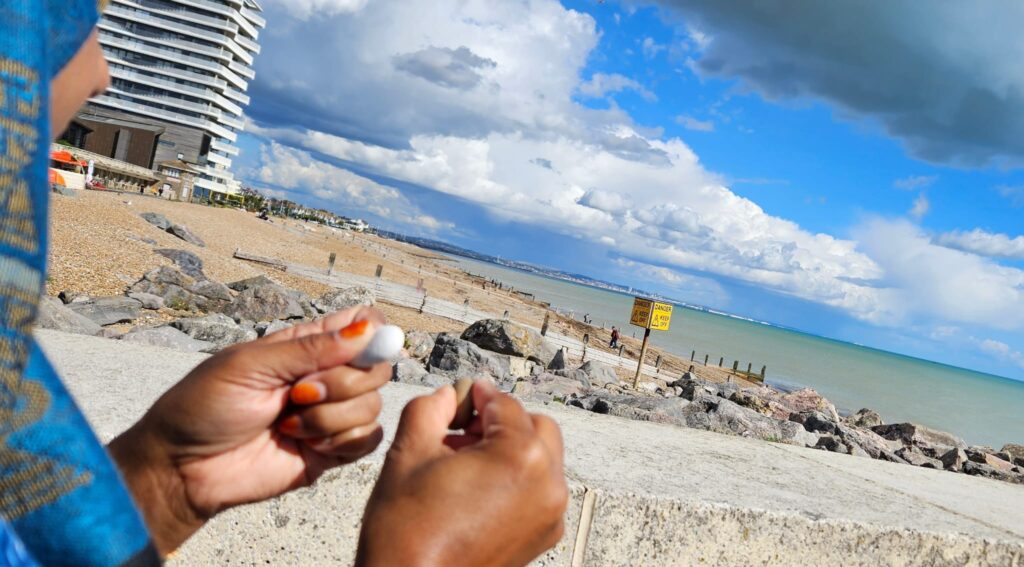
Sound Sparks film – coming soon
Sound Sparks summary of findings
Sound Sparks Report
Sound Spark ~ an idea or thought sparked by listening to a sound(s)
This post-doctoral project focused on knowledge exchange and dissemination from the PhD: extending the potential impact of the participatory listening research approach; applying these methods to other projects; and deepening the academic significance through presentations and publications.
I extended the toolbox by exploring how participatory listening walks could be co-created, and consulted on, to engage a range of people in listening to urban seaside gentrification across the Sussex coast sites. Together with Bela Emerson, we co-designed 3 Interactive Listening Walks based on the PhD findings. The Interactive Listening Walk format was able to be effectively applied to complex place-based findings because of its participatory, site, and topic-responsive design components. We consulted with 83 people through 6 pilots (residents, community groups, and policy-related professionals), 3 public events (mixed group), and 1 academic workshop (researchers and artists). We found that the Interactive Listening Walks generatively engaged people with different experiences and relationships to the neighbourhoods and topic. They sparked curiosity, learning, and new discoveries about sound and gentrification, as well as creating meaningful connections with the surrounding urban seaside environment. Through careful curation of listening, walking, and playing activities, we created an unusual intervention in participants’ everyday experiences of these neighbourhoods. Participants valued the time listening together, which supported conditions for dialogue and debate about policy and planning issues.
Who Owns Brighton: listening to redevelopment 2024
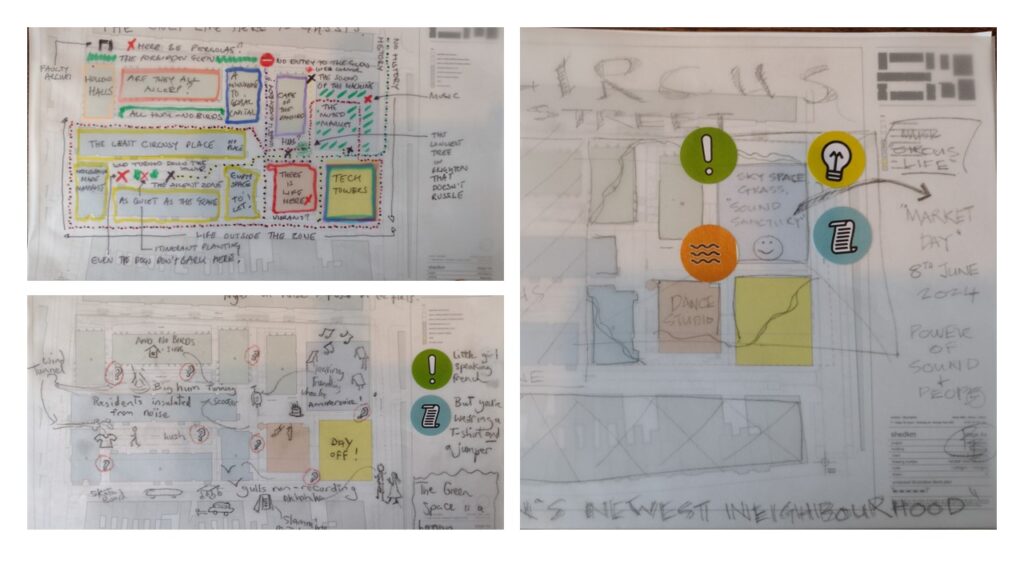
In summer 2024, I facilitated a participatory listening research day with community researchers from the Who Owns Brighton? (WOB) project. WOB is a participatory research project aiming to empower Brighton residents to better understand and shape different aspects of local planning and development process. I shared my toolbox to help explore the redevelopment case study site, Circus Street in Brighton.
The community researchers used silent listening, multi-media capture, group reflections, and participatory soundmapping to explore Circus Street and reflect on what they had been finding out about the site. We discovered that the redevelopment has produced a distinct acoustic environment, which contrasts with the surrounding city. There’s an uncomfortable juxtaposition between what was promised by the developers and what has been produced sonically e.g. “buzzing” vs “sterile space”. These acoustic dimensions impact the way people behave in the site e.g. a place to move though, not stop or interact in. Overall this application of the PLR toolbox demonstrated that listening and soundmapping can aid reflections and provide insightful engagement with a redevelopment site during a community research project.
The Ecomusicology Project: participatory soundmapping at Stanmer Organics 2023-2024
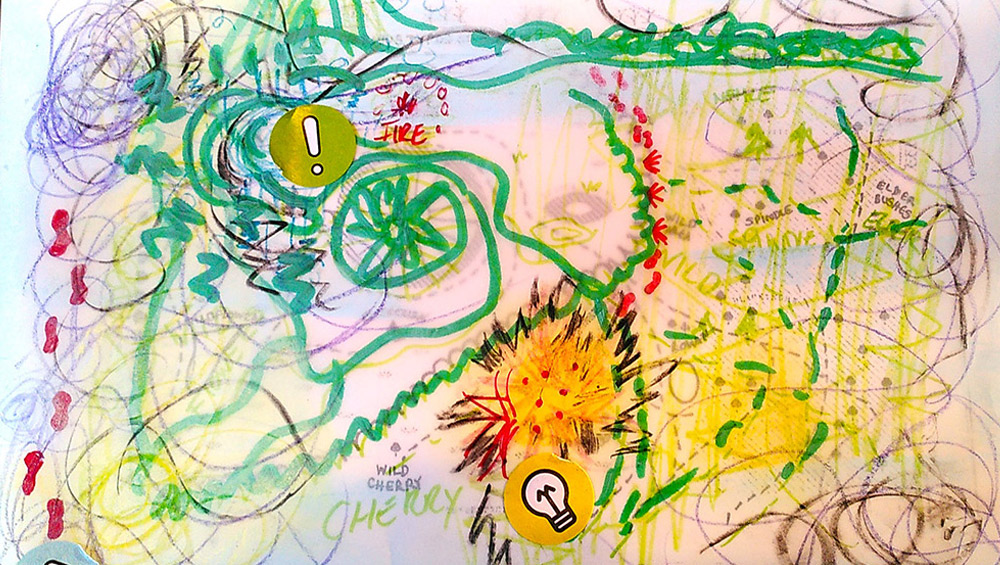
The Ecomusicology Project (TEP) is a collective comprising of sound artists, musicians, community practitioners, horticulturists, and makers, based at Stanmer Organics in Brighton. Through Brighton & Hove Music for Connection, I have been helping with volunteer days and supporting the collective activities. I have delivered Interactive Listening Walks with Bela Emerson, a Deep Listening session with Elona Hoover, and three participatory soundmapping workshops at the plot. Located on the urban fringe, these workshops have allowed me to apply the participatory listening research approach for ecological purposes.
Together with musicians, sound artists, makers, and the general public, we have explored the tensions and connections between man-made and non-made sounds and our differing responses to them. This collaboration has also allowed me to refine my participatory soundmapping tools – using “acoustic” and person-centred techniques and options to allow participants to visually and spatially capture and reflect on their listening experiences. The sound stimuli framework has been especially helpful in helping people think about their responses to sounds, clustered under “sound layers”, “sound surprises”, “sound sparks” and “sound stories”.
Post-graduate teaching: listening as method

Do the particular attributes of sound create a compelling rationale for their use in social sciences? Can listening be separated from a multisensory approach? Can attentive, deep, and careful listening generate empirical data that other methods cannot?
Since 2020, I have taught advanced research methods training for the University of Brighton School of Humanities & Social Sciences. I have shared the participatory listening research approach with post-graduate students on the Social Sciences (MRes) and Community Psychology (MA) courses. Research workshops have included immersive listening experiences and participatory soundmapping alongside an overview of sound studies, acoustic ecology, and sound art methodologies. Students have benefitted from exploring their research interests through a sonic methodology, an under-used sensory and creative approach. The activities have prompted reflections and ideas for their projects and widened their interdisciplinary knowledge and understanding. Using the PhD as a case study, I have also been able to share how new methodological endeavours can be developed through a research project and the vital importance of community engagement and collaborations in knowledge production.
AmbiMuse: researcher-artist residency at the University of Bordeaux 2025
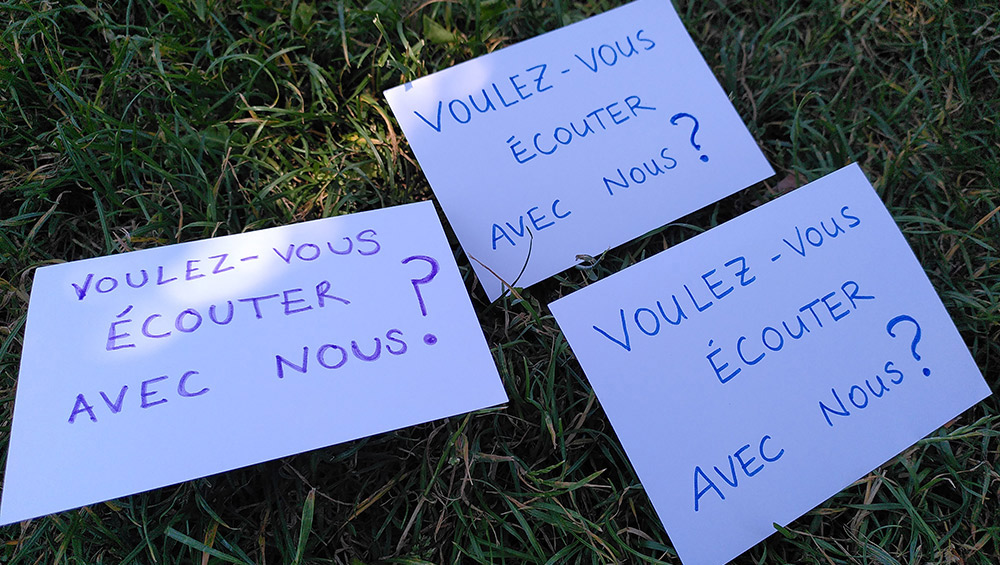
Through collaborating with Elona Hoover, I was invited to take up a researcher-artist residency in May 2025 at the University of Bordeaux. The residency was part of the AmbiMuse Festival in Bordeaux, a collaboration between Passage UMR 5319 CNRS research centre, Compagnie Aïla & Béton Communs. Together with Elona Hoover and CNRS members – Phillippe Woloszyn, Sara Ducloy, Kahina Ikni, Alexandra Ena, and Gaëlle Langeo – we created a sonic walking intervention in a public park in Bordeaux. This was accompanied by 2 days of presentations, exchanges, and discussions about our approaches to sound and the environment. My PLR approach has been technology-lite, driven by accessibility and inclusivity, but this exchange enabled me to explore how a range of audio and visual technologies can be used as “listening hooks” for public engagement.
In June 2025, Elona and I were able to host Phillipe and Sara at the University of Brighton for a sold out event, with thanks to funding from the University of Brighton Centre for Arts & Wellbeing, ESRC South Coast Doctoral Training Partnership and Passage UMR 5319 CNRS research centre. Commoning Sound – AmbiMuse in Brighton explored the potential of situated and critical listening practices as a way of “commoning”, that is of making and living well with human and non-human others, in often harsh and changing urban environments. Bela Emerson and I led an Interactive Listening Walk to the Waste House venue and Phillipe and Sara shared audio-visual material from the Bordeaux sonic intervention. Collaborations continue with planned creative outputs including a sound piece, film, and joint written publication.